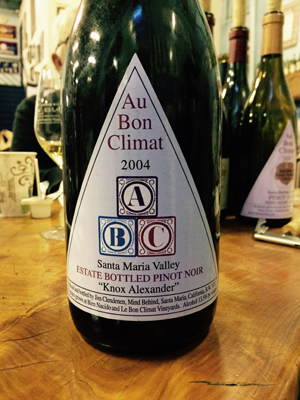Pioneers of Santa Barbara County Wine – Ken Brown, Longoria, Brander, Qupé/Au Bon Climat, Alma Rosa
I’ve posted a portion of a report on a mid-January wine trip with friends to visit with some of the pioneer vintners of Santa Barbara County. The full report can be found on the Grape-Nutz.com website – here’s the link:
Pioneers of Santa Barbara County Wine – January 2016
Ken Brown Wines
Longoria Wines
The Brander Vineyard
Qupé / Verdad Winery / Au Bon Climat / Clendenen Family Vineyards
Alma Rosa Winery & Vineyards
Grape-Nutz colleague Eric Anderson had talked with me late in 2015 about doing another January Central Coast wine tour, and that sounded like a great idea to me. We decided to get together a smaller group than we’d had for some past Central Coast trips – this time it was just Eric, his friend Michael, my friend Alan, and me.
As we usually do on these multi-day wine tours, we checked out a number of newer and lesser-known producers as well as a couple of more established ones – those visits will be covered in a separate Grape-Nutz report entitled “Central Coast – January 2016.” But I thought this trip might also be a great opportunity to visit some of the area’s wine pioneers, specifically from Santa Barbara County. I was fortunate enough to be able to arrange visits with a number of them, and it made sense to do this separate write-up for those visits.
Ken Brown, Rick Longoria, Fred Brander, Jim Clendenen, Bob Lindquist, and Richard Sanford all started working in the wine industry in Santa Barbara County in the 1970s, and all established their own wineries by the early 1980s. With the exception of Fred Brander (he was out of town but arranged for us to meet with his winemaker Fabian Bravo) we were able to visit all of these legendary vintners on this trip.
Qupé / Verdad Winery / Au Bon Climat / Clendenen Family Vineyards
We had about a 45-minute drive to our next destination, the winery shared by Bob and Louisa Sawyer Lindquist and by Jim Clendenen at Bien Nacido Vineyard in Santa Maria Valley. I’d seen both Bob and Louisa at various wine events over the past few years, and checked with them to see if a visit might be possible. I was delighted when they said they could accommodate our small group, and even more excited by their offer to have us join them for their staff lunch at the winery. For quite a few years, I had visited the winery nearly every spring for their open house – they’re generally open to the public only for their spring and fall open house events – but it had probably been ten years since I was last there. I did recall heading there the spring of California’s most recent major El Niño storms in 1998, when the heavy rains had washed out a small bridge along the route and the open house had to be cancelled – a disappointment that year. Since then, the bridge has been rebuilt to stand up to bigger storms.
[resizeableimage=360,255]http://www.grape-nutz.com/kenz/images/085-abc-+-qupe-+-verdad.jpg[/resizeableimage]
Even though I’d been to the winery before, I wisely asked for directions when I’d made the appointment since I remembered that the correct driveway off of Santa Maria Mesa Road was not easy to spot – it’s all but unmarked. The sun was coming out by the time we arrived at the winery after driving for a couple of miles through part the vineyard. Famed Bien Nacido Vineyard was first planted in 1973 – about 700 acres in size, it’s planted largely to Chardonnay and Pinot Noir but includes a dozen or more other varieties as well. There’s a reason the winery is set so far back in the vineyard – something that I’d heard before and that Bob Lindquist confirmed during our visit – the building is actually located across the county line in San Luis Obispo County. The permit process for building the winery back in 1989 was easier there than in Santa Barbara County. There have been four expansions to the original building since then to accommodate the winery’s growing production, most recently in 2008.
We walked into the small winery office and waited just a few moments until Bob and Louisa welcomed us. They let us know that Jim Clendenen was also there that day and was busy preparing lunch – he’s an outstanding cook as well as vintner, and he makes lunch for the winery staff nearly every weekday when he’s in town. It’s a great benefit of working there since the winery is miles from the nearest café or market, not to mention that Jim’s lunches are legendary. I actually hadn’t checked whether Jim would be available when I’d arranged our visit – I’d figured we’d probably have enough on our plate already with seeing Bob and Louisa – so being able to see him as well was an added bonus.
The main producers in the large winery building – Au Bon Climat and Qupé – are among Santa Barbara County’s oldest and best-known, while Verdad and Clendenen Family are smaller but also produce excellent wines. All deserve a brief introduction, so let’s start with Jim Clendenen, the first of this group on the Santa Barbara wine scene. Jim is originally from Ohio and studied at UC Santa Barbara with the intent of pursuing a degree in law. But a trip to Burgundy and other French wine regions helped turn his interests in the direction of winemaking. He joined Zaca Mesa Winery in 1978 as assistant winemaker, working there with Ken Brown. Jim founded Au Bon Climat with fellow Zaca Mesa-alum Adam Tolmach (now of Ojai Vineyard) in 1982, and quickly became one of Santa Barbara County’s leading producers of Chardonnay and Pinot Noir. Wines were first made in an old dairy barn before Jim and Bob built their shared winery in 1989. Fruit sources include Bien Nacido Vineyard and other highly-regarded southern Central Coast sites, including a couple of vineyards developed by Jim and his family (more on that shortly). Au Bon Climat also produces Pinot Gris and Pinot Blanc, and annual production has grown to over 40,000 cases.
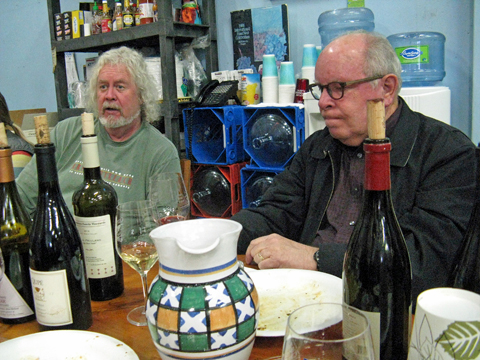
Jim Clendenen with Eric Anderson
Jim established another wine label in 2000 – Clendenen Family Vineyards. The fruit comes largely from two vineyards owned by – you guessed it – the Clendenen family. Le Bon Climat Vineyard is in the Sisquoc area across the river from Bien Nacido, while Rancho La Cuna is located in Los Alamos Valley. Production is tiny in comparison to Au Bon Climat, and the wines for Clendenen Family allow Jim an opportunity to work with a broad range grape varieties, including Chardonnay, Pinot Noir, Gewürztraminer, Viognier, Sauvignon Blanc, Aligoté, Tocai Friulano, Mondeuse Rosé, Syrah, Petit Verdot, Refosco, and Nebbiolo. Of these, the Italian varieties may have received the most attention but I’ve been impressed by just about all the Clendenen Family wines I’ve tasted.
Born in the Midwest, Bob Lindquist moved to Southern California when he was 11, and he soon developed a serious passion for Dodgers baseball – he’s seldom seen without a Dodgers shirt or cap. He became interested in wine while attending UC Irvine and by the mid-1970s he was working for wineries in Santa Clara Valley near Gilroy. Wine business opportunities led him to move to Santa Ynez Valley in 1979, and through the owner of a wine shop Bob was managing in Los Olivos, he met Jim Clendenen, who was working at Zaca Mesa at the time. Before long, Jim hired Bob as Zaca Mesa’s first-ever winery tour guide. Bob launched Qupé in 1982, starting out with Chardonnay, Pinot Rosé, and Syrah, but before long he sharpened the winery’s focus to Rhône grape varieties. The winery name – pronounced kyoo-pay – is the Chumash Indian word for California poppy, a stylized illustration of which is featured on the wine labels. In 1989 Bob joined Jim in their new shared winery at Bien Nacido Vineyard.
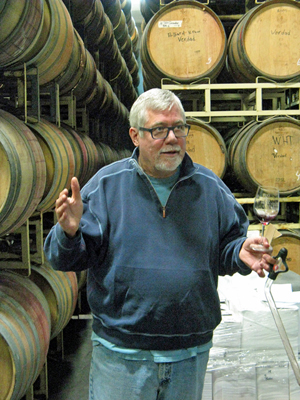
Bob Lindquist
In 2005, Bob and Louisa established their Sawyer Lindquist Vineyard in Edna Valley. It’s planted with Syrah, Grenache, Tempranillo, Albariño, Viognier, Marsanne (mostly for dessert wine), and Pinot Noir, and has been farmed biodynamically from the start. In 2013, investor Charles Banks became the majority owner of Qupé – he has acquired ownership in a number of top-notch wineries in recent years. With Qupé producing around 40,000 cases each year, the goal was to allow Charles Banks and his Terroir Selections take charge of sales and marketing to allow Bob to focus more time in the vineyard and winery. In talking with both Bob and Louisa during our visit, both seem excited about this, and they noted that nothing of substance has changed in the way they go about their winemaking as a result of the new business arrangement.
Louisa grew up in the New York area and has a degree in biology from Long Island University. She became interested in wine and worked for Hargrave Vineyard and other vintners on the East End of Long Island, as well as for wine retailers and importers. After moving to California, she met Bob in the 1990s, and around the same time, she developed an interest in Albariño. Louisa launched her Verdad wine label in 2000 – it’s another pioneering winery, one of the first in California to focus on wines from Spanish grape varieties. Verdad and Havens were the first two Albariños made in California – Verdad’s first one was from the 2000 vintage. Verdad also produces a dry Grenache-based Rosé, Tempranillo, and Graciano. A good deal of Verdad’s fruit comes from two vineyard sources – Ibarra-Young Vineyard in Los Olivos, and Sawyer Lindquist Vineyard. Louisa told us that she’s been impressed with the health of the Sawyer Lindquist soil and vines as a result of the biodynamic farming methods there. Over the years, I’ve found Verdad to be among the finest of California’s wines made from Iberian grape varieties.
It’s worth noting that Bob and Jim have worked with and helped mentor many other winemakers at their facility over the years, including Frank Ostini and Gray Hartley of Hitching Post, Paul Lato, Morgan Clendenen of Cold Heaven, Gary Burk of Costa de Oro, and Gavin Chanin.
Bob grabbed wineglasses for our group and led us back into one of the large barrel rooms to taste some samples of his own wines as well as a few from Au Bon Climat and Verdad. We started out with four Qupé whites from the 2015 vintage. We compared Viognier from Bien Nacido and Sawyer Lindquist vineyards, both from neutral barrels. Bob said that the one from Bien Nacido will go into the Qupé budget-priced “A Modern White” – a blend of Chardonnay, Viognier, and Marsanne that replaced their “Bien Nacido Cuvée” starting with the 2014 vintage. Moving on, we tried Marsanne from Sawyer Lindquist and Roussanne from Bien Nacido. Bob’s Marsannes are amazingly long-lived – I had the pleasure of attending a dinner last year where he brought his 1993 Qupé Marsanne, and it was stunning. The Roussanne, unlike the first three wines, came from a newer barrel – this is another wine that has a great track record for aging. He told us that some fermentation lots are inoculated with a selected yeast strain but not others, but that they don’t particularly need to inoculate since there is so much yeast present in the winery. I asked Bob whether he’d ever made a botrytized Roussanne, but he said that the area tends to be too dry for botrytis to grow well.
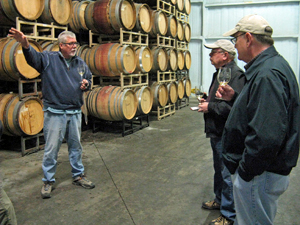
Barrel tasting with Bob Lindquist
Bob switched gears to pull samples of two Au Bon Climat wines – 2014 Chardonnay from Bien Nacido and 2014 Pinot Noir from Sanford & Benedict. The Chardonnay will be a component of the “Nuits-Blanches au Bouge” bottling – it spent one year in new barrels and was then racked into neutral ones. The Pinot was fermented with 100% whole clusters but wasn’t “stemmy” at all. Two bigger 2014 reds from Sawyer Lindquist Vineyard followed – Verdad Tempranillo and Qupé Syrah. This cooler-climate planting helps these varieties to retain acidity. Bob told us that the Syrah will go into the “Sonnie’s” bottling – this gets more whole-cluster fermentation and aging in more new oak, and it’s been a standout over the years. Bob mentioned that both he and Jim use almost all François Frères for whites, and Jim uses them for Pinots as well. Bob likes Ermitage barrels for the Qupé reds. He also told us that he uses only barriques, Jim uses some puncheons for Sauvignon Blanc and Nebbiolo for his Clendenen Family wines, and Louisa uses puncheons for her Verdad Tempranillo and Graciano.
As we were finishing the Syrah, Louisa came over to let us know that lunch was ready. We made our way back to the first big winery space, where a large area is devoted to the kitchen and long lunch table – a unique and beautiful piece made from a single tree trunk. Jim gathered everyone around to give us all a short description of the food that he’d prepared. He’d recently returned from a trip to Thailand and he’d made an array of Thai-inspired dishes: pork with cilantro, peanut, jalapeño, rice vinegar, and onion; shrimp, pork, and eggplant; beef salad; and pomelo, pineapple, melon and kale. Jim made everything so it was not too spicy but there were various hot sauces available at the table to spice things up. The food was served buffet-style and we sat down with the winemakers and about eight other members of the winery staff. There was an assortment of bottles on the table to enjoy with lunch, with new and recent releases of Albariño from Verdad, Tocai Friulano, Viognier, and Pinot Noir from Clendenen Family Vineyards, Pinot Noir from Barham Mendelsohn (Jim is the winemaker), Roussanne and Syrah from Qupé, and Pinot Noir from Au Bon Climat.
[resizeableimage=360,270]http://www.grape-nutz.com/kenz/images/094-abc-+-qupe-+-verdad.jpg[/resizeableimage]
I’d heard a little about the lunches here, but this was beyond all expectations – all of the dishes that Jim prepared were delicious. Our group was fortunate to have been able to join in for lunch with Jim, Bob, Louisa, and their crew, and it was certainly an unforgettable experience. It was tough to jot down detailed notes on all the wines we had with lunch but with so much interesting conversation going on the entire time, but I gave it a shot. It was no surprise that all the wines on the table were very good, with some real standouts. Bob had to leave after awhile, but we continued our conversation at the table, particularly some very lively discussions with Jim. Unlike so many of the area’s relatively low-key and soft-spoken wine pioneers, Jim is quite the opposite!
At one point in our conversations with Jim, we mentioned to him that we’d been a bit disappointed by a couple of 2004 Pinot Noirs from very good producers that we’d opened at dinner a couple of nights earlier, and he pulled out a couple of his 2004 Au Bon Climat Pinots for us to try! He mentioned that both (“La Bauge Au-dessus” and “Knox Alexander”) were really still too young – he feels that about 15 years of bottle age is usually about right to start drinking his higher-end bottlings – but both showed well, certainly better than the Pinots we’d had at our earlier dinner. Opening those two wines for us was most generous, and it showed how well the Au Bon Climat Pinots can age.
We could have spent the whole afternoon talking with Jim, but with one more appointment coming up later in the afternoon, we wanted to taste some Verdad wines with Louisa before we left. After heading back into the barrel room, we first tried a 2015 Albariño from Paragon Vineyard in Edna Valley. Fruit is generally picked on the early side to preserve acidity, and Louisa makes her Albariño in both stainless steel and neutral oak. We continued with a couple of 2014 Grenache samples, from Sawyer Lindquist and Alamo Creek vineyards. Louisa told us that she’ll blend this Sawyer Lindquist Grenache with Tempranillo for a single-vineyard blend. Alamo Creek is a site east of Nipomo in southern San Luis Obispo County.
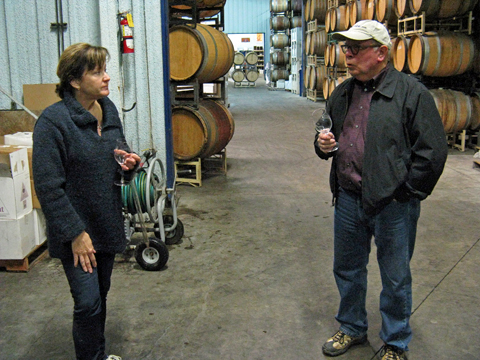
Louisa Sawyer Lindquist with Eric Anderson
Louisa was excited about Cabernet Sauvignon she’s gotten the past two years from Pine Hawk Vineyard near San Miguel, just north of Paso Robles. The vineyard is farmed biodynamically, and Louisa said that she may make a Priorat-style blend using this wine. We tasted samples from both 2014 and 2015 – the 2014 spent one year in 25% new Taransaud barrels and has been blended and racked into neutral oak, and Louisa plans to do a similar treatment with the 2015 wine. Our final sample was from a tank of 2015 Albariño from Sawyer Lindquist Vineyard. Louisa makes two picks for the Albariño from there, an earlier one for more acidity and another about ten days later for more intense flavor. This one was from the later, riper pick but it still displayed the chalky, minerally character I’ve often found with wines from this vineyard.
It’s always tough to judge barrel and tank samples, since most will be blended with other components for the finished wines – part of why I’ve avoided including them among my favorites for this Central Coast report as a whole. But since we tasted so many barrel samples with Bob and Louisa, I wanted to make note of the ones I thought were most promising. These included the Qupé 2015 Sawyer Lindquist Vineyard Viognier, Qupé 2015 Bien Nacido Roussanne, Au Bon Climat 2014 Sanford & Benedict Vineyard 100% whole-cluster Pinot Noir, Verdad 2014 Sawyer Lindquist Vineyard Tempranillo, Verdad 2014 Sawyer Lindquist Vineyard Grenache, and Verdad 2014 Pine Hawk Vineyard Cabernet Sauvignon. And among the bottled wines we had with our lunch, my favorites were the Verdad 2014 Sawyer Lindquist Vineyard Albariño, Clendenen Family 2013 Le Bon Climat Vineyard Viognier, Qupé 2012 “Sonnie’s” Syrah, and 2004 Au Bon Climat “Knox Alexander” Pinot Noir. Wow, that was a lot of really good wine! And the others that we tasted were quite nice as well.
Our visit with Bob, Louisa, and Jim was without question a highlight of our trip. Many noteworthy wines, a fantastic lunch (thanks, Jim!), and plenty of informative and entertaining conversation with three of Santa Barbara County’s finest vintners. It’s not every day that you’re hosted by two of the region’s real wine pioneers as well as one who’s helped pioneer a whole new group of grape varieties in California. This visit was certainly a memorable one for Eric, Michael, Alan, and me, and we’re very appreciative of the generous hospitality that Bob, Louisa, and Jim showed us. Their wineries may no longer be new discoveries, but they’ve never stopped striving – and succeeding – to set the quality bar higher, and our visit showed that we’ll continue to see plenty of outstanding wines from all of them in the coming years.
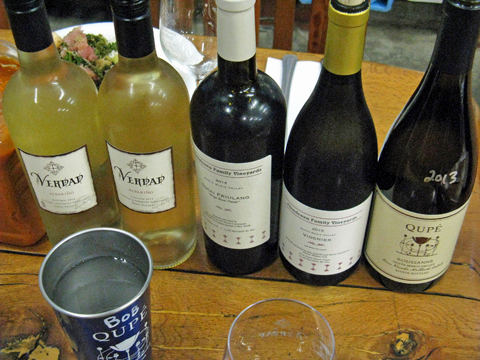
Barrel samples and tank samples
Qupé 2015 Viognier, Bien Nacido Vineyard, Santa Maria Valley (barrel sample). Medium-light yellow color, with ripe tropical fruit and floral aromas and a rich texture.
Qupé 2015 Viognier, Sawyer Lindquist Vineyard, Edna Valley (barrel sample). Light yellow, bright and fresh citrus with herbal undertones, lively mouthfeel.
Qupé 2015 Marsanne, Sawyer Lindquist Vineyard, Edna Valley (barrel sample). This displayed pear, apple, and waxy notes, medium weight with great acidity.
Qupé 2015 Roussanne, Bien Nacido Vineyard, Santa Maria Valley (barrel sample). Aromas of citrus and stone fruit with some spice and a stony mineral note, rich texture, should age well.
Au Bon Climat 2014 Chardonnay, Bien Nacido Vineyard, Santa Maria Valley (barrel sample). Pear and stone fruit on the nose along with vanilla/oak and spice, creamy mouthfeel and finish.
Au Bon Climat 2014 Pinot Noir, Sanford & Benedict Vineyard, Sta. Rita Hills (barrel sample). Lots of spice plus red fruits, herbs, and earth, with a bright texture and moderate, chalky tannins.
Verdad 2014 Tempranillo, Sawyer Lindquist Vineyard, Edna Valley (barrel sample). Upfront tobacco and dried herb aromas with ripe plum and earth, fresh mouthfeel with a chewy tannic finish.
Qupé 2014 Syrah, Sawyer Lindquist Vineyard, Edna Valley (barrel sample). This had fresh dark berry fruit, flowers, and a touch of pepper on the nose, medium-bodied with a lively texture and finish.
Verdad 2015 Albariño, Paragon Vineyard, Edna Valley (barrel sample). Very floral aromatics along with tropical fruit notes, medium weight with a clean finish.
Verdad 2014 Grenache, Sawyer Lindquist Vineyard, Edna Valley (barrel sample). Medium color, with bright and subtle strawberry, earth, and black pepper, medium-light bodied with chalky tannins.
Verdad 2014 Grenache, Alamo Creek Vineyard, San Luis Obispo County (barrel sample). Upfront ripe red fruit aromas with a savory component, medium-bodied with moderate tannins.
Verdad 2014 Cabernet Sauvignon, Pine Hawk Vineyard (barrel sample). Aromas of dried herb, currant and darker fruit, and pencilly oak, medium-full bodied with big but fine tannins.
Verdad 2015 Cabernet Sauvignon, Pine Hawk Vineyard (barrel sample). Medium-dark purple, a bit less ripe than the 2014, more herbal and more focused fruit, structured mouthfeel with grippier tannins.
Verdad 2015 Albariño, Sawyer Lindquist Vineyard, Edna Valley (tank sample). From “lot 2” – a later/riper pick that will be blended with wine from earlier-picked fruit. Fresh ripe apple aromas along with fresh herbs and a stony mineral component, slightly chalky texture and clean finish.
Lunch wines – recent releases and library wines
Verdad 2014 Albariño, Sawyer Lindquist Vineyard, Edna Valley. Citrus and stone fruit on the nose along with undertones of flowers and stony minerals. Medium-light bodied with vibrant acidity and a fresh finish, nice.
Verdad 2013 Albariño, Sawyer Lindquist Vineyard, Edna Valley. Light straw color, tropical fruit and peach aromas. A little more weight on the palate than the previous wine but still with a lively mouthfeel and finish.
Clendenen Family Vineyards 2014 Tocai Friulano, “Borgo Buon Natale,” Santa Maria Valley. Light color, this featured pear and stone fruit with a distinct floral component. Medium-bodied with a pleasant texture and clean finish.
Clendenen Family Vineyards 2013 Viognier, Le Bon Climat Vineyard, Santa Maria Valley. Subtle stone fruit and floral aromas and a touch of fresh herbs. Medium weight with fine acidity and a long, tasty finish, nice.
Qupé 2013 Roussanne, “Hillside Estate,” Bien Nacido Vineyard, Santa Maria Valley. Light yellow, earth, pear, and touches of honey and spice, moderately rich texture and will benefit from aging.
Clendenen Family Vineyards 2012 Pinot Noir, Le Bon Climat Vineyard, Santa Maria Valley. Medium-light ruby, with upfront floral aromas plus black cherry and plum fruit and a tea leaf note. Medium-bodied with a lively mouthfeel and finish.
Barham Mendelsohn 2009 Pinot Noir, Estate, Russian River Valley. Riper red and black fruits with notable spice and sweet oak components. Richer texture and finish.
Au Bon Climat 2007 Pinot Noir, Sierra Madre Vineyard, Santa Maria Valley. Ripe red fruit, spice, and earth on the nose. Medium-bodied and moderately rich.
Qupé 2012 Syrah, “Sonnie’s,” Sawyer Lindquist Vineyard, Edna Valley. Pretty floral notes along with blackberry, pepper and well-integrated oak. Structured on the palate with firm tannins, should age very well, nice.
Au Bon Climat 2004 Pinot Noir, “La Bauge Au-dessus,” Bien Nacido Vineyard, Santa Maria Valley (library wine). Medium-light garnet color with slight bricking, this was savory with some brambly herbal and earthy notes, and it showed more ripe red fruit as it opened up in the glass. Medium-bodied and still nicely structured, finishing with fine tannins.
Au Bon Climat 2004 Pinot Noir, “Knox Alexander,” Estate, Santa Maria Valley (library wine). Medium-light garnet, this had a more earthy character, with more subtle black cherry and plum notes along with touches of tea leaf and spice. A bit bigger on the palate with more structure than the previous wine and still-chalky tannins on the finish – developing nicely with years ahead of it.
